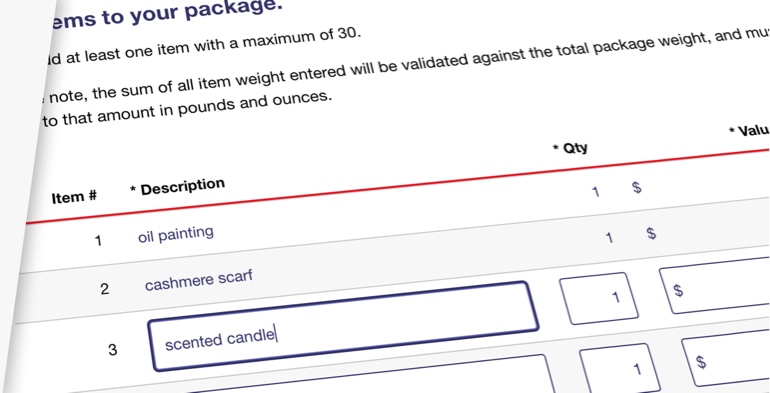New Customs Requirements for Packages to European Union (EU) Countries
If you're shipping packages to countries that follow European Union (EU) customs rules, there are new customs regulations you'll need to follow. If you don't provide more-detailed content descriptions on your customs forms, your packages may be returned or refused. USPS is providing tools to help shippers comply with these new rules.
What You Need to Know
A partir del 1 de marzo de 2023:
- New customs rules apply to all outbound international packages going to European countries that follow EU customs regulations. Esto incluye los obsequios personales, los pedidos de comercio electrónico y el correo militar y diplomático (APO/DPO/FPO).
- Every item in your package must be listed on the customs declaration form.
- For each item's description: No puede simplemente nombrar una categoría general; su descripción debe ser específica. For example, you can't just say "electronics"; you have to be specific about the type of electronics, like "computer," "mobile phone," or "television."
- If you use USPS® tools (like the International Retail Postage Price Calculator or Global Shipping Software) and provide acceptable descriptions (that are specific and accurate), USPS will provide an "HS (Harmonized System) Tariff Code" (or just "HS Code"). This USPS-generated code will be included on your customs declaration form.
Orientación para Descripciones Aceptables
| Inaceptable | Aceptable |
|---|---|
| Ropa | Camisas de hombre, chaleco de niña, chaquetas de niño |
| Accesorios | Refrigerador, estufa, horno de microondas |
| Ilustraciones | Pintura al óleo, dibujo a lápiz, estatua de bronce |
| Batería | Baterías de litio |
| Regalos | Vela perfumada, auto a control remoto, bufanda de cachemira |
| Medicamento | Analgésicos, rocío antiviral |
| Productos de Salud y Belleza | Detergente, cepillo de dientes, toallas |
| Vegetales | Berenjena, cebollas, brócoli |
Countries That Follow European Union (EU) Customs Rules
- Austria
- Belgium
- Bulgaria
- Croatia
- Cyprus, Republic of
- Czech Republic
- Denmark
- Estonia
- Finland
- France
- Germany
- Greece
- Hungary
- Ireland
- Italy
- Latvia
- Lithuania
- Luxembourg
- Malta
- Netherlands
- Norway
- Poland
- Portugal
- Romania
- Slovakia
- Slovenia
- Spain
- Sweden
- Switzerland
Why These Changes Are Important
Outbound U.S. shippers send tens of millions of packages to EU countries each year. However, if you don't comply with new requirements in EU customs rules, your shipments will be at risk. Don't jeopardize your packages, revenue, and customer satisfaction!
Para Negocios
- Prevent loss of international outbound revenue
- Follow new EU regulations, reducing fraud and increasing accountability
- Improve speed and efficiency of cross-border ecommerce
- Meet safety and security requirements, preventing delays, fines, and penalties for noncompliance
- Increase competitiveness
Para Consumidores
- Know EU rules and how to properly describe contents in international shipments
- Send packages with peace of mind, avoiding delayed, discarded, or destroyed packages





